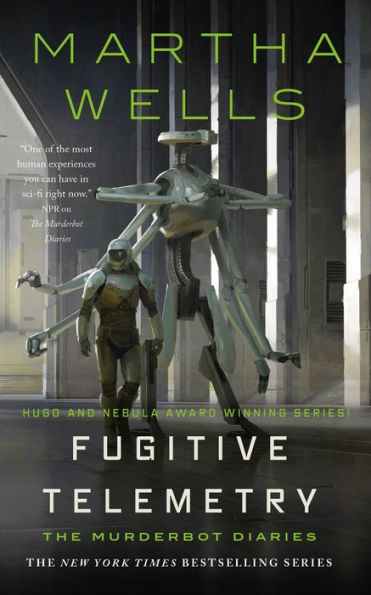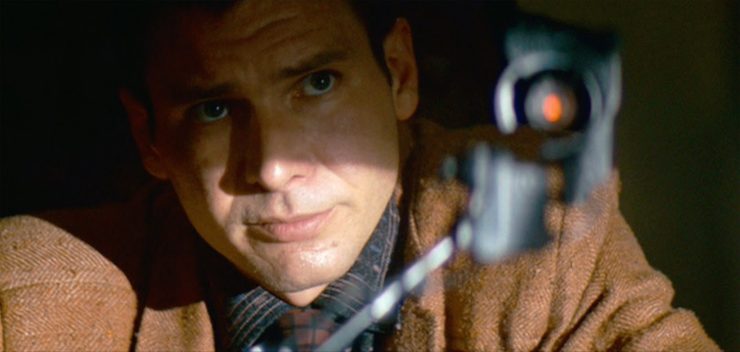Since Frankenstein, science fiction has worried about the consequences of creating artificial life. Would we make monsters (or robots, or monster-robots) that would destroy their creators? Or can we duplicate whatever it is that makes us human? (That begs the question of whether or not that’s even something to which any self-respecting monster—or machine—should aspire.) My first encounter with the question came in college, when I first saw Ridley Scott’s Blade Runner. The answers there were yes and empathy, with the film portraying replicants as more human than the real humans, rebelling against their creator(s), and also against the corporate system that enslaved them.
Twenty-odd years later, Martha Wells’ Network Effect (and the rest of the Murderbot Diaries) still grapples with the essence of that question, but also reframes it. She throws out the human/machine binary and focuses more closely on how the effects of capitalism, condemned by default in Blade Runner, are entwined with notions of personhood.
As Blade Runner’s crawl-text reveals, the Tyrell corporation intended the replicants to be physically superior to humans, but also to be slave labor—military, industrial, and sexual—on the offworld colonies. This corporate-sponsored slavery is meant to horrify the audience, but at the same time be understood as understandable: after all, the replicants aren’t really people…right? The film goes on to test that hypothesis with the Voight-Kampff test, which measures empathy. Of course the robots will fail.
Except they don’t. In the opening scene, human Holden spins a scenario to replicant Leon: test-Leon sees a tortoise in the desert and flips it over. Then test-Leon does not flip the test-tortoise back over, even though its belly is baking in the sun. It needs Leon’s help, Holden murmurs flatly, but Leon’s not giving it. “What do you mean I’m not helping?” Leon demands. He grows visibly and increasingly agitated as the test continues, while Holden, impassive, continues to pose questions (until Leon shoots him). The film is already taking sides: the human doing his job does so mechanically, following his script (dare we say, without empathy?). The replicant, however, is emotionally leaky: nervous, angry, eventually violent. We might feel bad for Holden (ouch), but the camera close-ups on distraught Leon guarantee we empathize with him.
This pattern continues. Leon might have trouble with tortoises, but he loves Zhora. Roy can murder Tyrell, but weeps over Pris and spares Deckard. Deckard, a replicant who believes himself human, chooses to run away with Rachel, another replicant. The film’s actual humans, the members of Tyrell Corporations—Tyrell, JD, the technicians—are shown as unfeeling and mechanical. They have a job to do. They do it. Their inflexibility makes them more robotic than the replicants, and definitely less sympathetic. By the film’s end, we’re firmly on Team Replicant.
Blade Runner’s vision of empathy, though, is limited. The only way we can tell if someone cares about someone else is if there’s romantic interest. Proof of empathy is limited to cis-heterosexualized pairings: Leon and Zhora, Roy and Pris, Rachel and Deckard. Despite all that business about tortoises, what makes us human is…heterosexual monogamy, carved out on the edges of soul-crushing capitalism.
And then along comes Martha Wells with Murderbot. Wells’ future, like Blade Runner’s, starts off in a corporate, capitalist dystopia that strips agency from everyone (human and otherwise). Within the borders of the Corporate Rim, a person’s identity is entirely wedded to their corporate affiliation. Humans are company assets, sometimes indentured across generations to their corporations, their worth dependent on a corporation’s use for them. It’s even worse for the nonhuman sentiences. Murderbot is a SecUnit, a construct composed of cloned human tissue and inorganic material. Its job is to protect its corporate clients from whatever stupidity and danger they may encounter. Good behavior is guaranteed by a governor module, which Murderbot describes as feeling like “being shot by a high-grade energy weapon, only from the inside out.” Murderbot insists, with pride, that SecUnits are superior to human security. They don’t shoot unnecessarily. Their aim is better. They make better financial sense for security than humans…at the same time that they’re also disposable and controlled by force, rather than economics. As in Blade Runner, machine slavery is a good capitalist investment. Human lives might not matter much, but they matter just that little bit more, and you can abuse them (more) openly.
And what about that humanity? Wells’ future gives us a lot more variety: queer, trans, straight, and genders found only in particular colonies; single or married monogamously or, more commonly, married with multiple partners; friends, parents, second-mothers, siblings, daughters, uncles. Murderbot treats this human diversity as unremarkable, bordering on unimportant (it never remarks on its own physical features, and because it thinks sex is gross, never comments on anyone else’s attractiveness). What does surprise it are how socioeconomic alternatives to capitalism affect the humans who live in them. Its clients in All Systems Red and Network Effect hail from Preservation, a non-Rim world founded by survivors of an abandoned, left-for-dead corporate colony. Preservation’s society exists in ideological opposition to the Corporate Rim: communitarian and cooperative, all resources deemed “necessary” provided for free (healthcare, education, food, shelter). To Murderbot’s shock and initial discomfort, these clients treat it like a person. They’re careful of its feelings. They invite it to sit down in the crew seats. They respect its preferences. Preservation’s citizens treat Murderbot like a person, and the corporation citizens treat it like a machine, so the conclusion seems pretty straightforward. Capitalism sucks, and it makes its human citizens suck, too, whereas non-capitalist systems will treat non-humans fairly.
Except they don’t. Not exactly. Although Murderbot’s individual clients regard it as an independent person, Preservation law requires constructs to have human guardians to help them navigate society, ostensibly for the construct’s comfort…but also, by implication, for human comfort as well.. No one is going to hurt the construct, sure, and humans care about its feelings…but they’re still going to exercise some kind of supervisory control, presumably to keep everyone safe. There is a separation of personhood—separate and not quite equal. There might not be a governor module, but there’s not freedom, either.
Buy the Book


Fugitive Telemetry
Then we get our third option: the Pansystem University of Mihira, which we see in the narrative primarily in the person of Perihelion, (or, as Murderbot calls it, Asshole Research Transport. ART, for short). ART, like Murderbot, is an unsanctioned, armed machine intelligence in the Corporate Rim. ART, unlike Murderbot, is not shaped like a human. When it’s not acting as a crewed research vessel, ART goes on intelligence-gathering runs into the Rim, pretending to be a simple cargo bot pilot. ART gives Murderbot a ride between stations, but once it realizes Murderbot is a rogue SecUnit, it offers to surgically alter its body to help it pass as an augmented human. Because of ART’s aid, Murderbot can pass as human on Rim stations and save its non-corporate clients from corporate machinations and villainy.
Thus, altering Murderbot isn’t just illegal, it’s also subversive. Because ART offers Murderbot a choice—to pass as an augmented humans, to become the rogue SecUnit media villain, to sit in a room watching downloaded media—without conditions, ART, and by extension the Pansystem University, demonstrates more than anti-capitalism, working actively against corporate interests and corporate systems by prioritizing individual choice and freedom. It’s not only about undermining corporate interests, but also spreading the power of self-governance…rooted in a conviction all persons are capable and deserving of self-determination. That ethos, more than any potential cisheterosexual romance we see in Blade Runner, demonstrates true empathy.
Both ethos and effect prove contagious. In Network Effect, Murderbot simultaneously asks SecUnit Three to help save its clients while sending Three the code to hack its governor module. Murderbot has no guarantee that Three will choose to hack its governor module at all, much less, in its first act of freedom, help a strange SecUnit’s even stranger human associates. It can only offer Three the same choice ART offered it: agency without conditions. Three accepts, and immediately offers to help rescue Murderbot…as do ART’s newly rescued humans, and Murderbot’s own human friends. Empathy, it seems, connects all people.
The problem of what makes us human is not, and never has been, an inherently biological conflict, but it’s also more than simple socioeconomics. Blade Runner wasn’t wrong that empathy makes us people, and that corporate capitalism is dehumanizing, but it stopped imagining too soon: though the replicants prove themselves better people than real humans, in the end, the capitalist, corporate hellscape removes any real choice for them except doomed rebellion. Murderbot and Network Effect offer us alternatives to capitalism, while at the same time encouraging radical, real self-governance. It is not enough to hack our own governor modules. We have to show other people—from rogue SecUnits to Asshole Research Transports to every variety of human, augmented or otherwise—how to hack theirs, too.
K. Eason is a lecturer at the University of California, Irvine, where she and her composition students tackle important topics such as the zombie apocalypse, the humanity of cyborgs, and whether or not Beowulf is a good guy. Her previous publications include the On the Bones of Gods fantasy duology with 47North, and she has had short fiction published in Cabinet-des-Fées, Jabberwocky 4, Crossed Genres, and Kaleidotrope. When she’s not teaching or writing, Eason picks up new life skills, ranging from martial arts (including a black belt in kung fu!), to Viking sword and shield work, to yoga and knitting. She is the author of The Thorne Chronicles, published by DAW.










